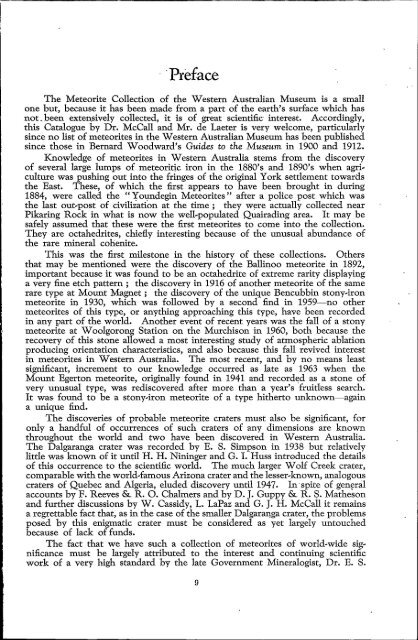catalogue of western australian meteorite collections
catalogue of western australian meteorite collections
catalogue of western australian meteorite collections
You also want an ePaper? Increase the reach of your titles
YUMPU automatically turns print PDFs into web optimized ePapers that Google loves.
"Preface<br />
The Meteorite Collection <strong>of</strong> the Western Australian Museum is a small<br />
one but, because it has been made from a part <strong>of</strong> the earth's surface which has<br />
not _been extensively collected, it is <strong>of</strong> great scientific' interest. Accordingly,<br />
this Catalogue by Dr. McCall and Mr. de Laeter is very welcome, particularly<br />
since no list <strong>of</strong> <strong>meteorite</strong>s in the Western Australian Museum has been published<br />
since those in Bernard Woodward's Guides to the Museum in 1900 and 1912.<br />
Knowledge <strong>of</strong> <strong>meteorite</strong>s in Western Australia stems from the discovery<br />
<strong>of</strong> several large lumps <strong>of</strong> meteoritic iron in the 1880's and 1890's when agriculture<br />
was pushing out into the fringes <strong>of</strong> the original York settlement towards<br />
the East. These, <strong>of</strong> which the first appears to have been brought in during<br />
1884, were call~d the "Yo~ndegin Meteorites" after a police post which was<br />
the last out-post <strong>of</strong> civilization at the time; they w~re actually collected near<br />
Pikaring Rock in what is now the well-populated Quairading area. It may be<br />
safely assumed that these were the first <strong>meteorite</strong>s to come into the collection.<br />
They are octahedrites, chiefly interesting because <strong>of</strong> the unusual abundance <strong>of</strong><br />
the rare mineral cohenite.<br />
This was the first milestone in the history <strong>of</strong> these <strong>collections</strong>. Others<br />
that may be mentioned were the discovery <strong>of</strong> the Ballil100 <strong>meteorite</strong> in 1892,<br />
important because it was found to be an octahedrite <strong>of</strong> extreme rarity displaying<br />
a very fine etch pattern; the discovery in 1916 <strong>of</strong> another <strong>meteorite</strong> <strong>of</strong> the same<br />
rare type at Mount Magnet; the discovery <strong>of</strong> the unique Bencubbin stony-iron<br />
<strong>meteorite</strong> in 1930, which was followed by a second find in 1959-no other<br />
<strong>meteorite</strong>s <strong>of</strong> this type, or anything approaching this type, have been recorded<br />
in any part <strong>of</strong> the world. Another event <strong>of</strong> recent years was the fall <strong>of</strong> a stony<br />
<strong>meteorite</strong> at W oolgorong Station on the Murchison in 1960, Both because the<br />
recovery <strong>of</strong> this stone allowed a most interesting study <strong>of</strong> atmospheric ablation<br />
producing orientation characteristics, and also because this fall revived interest<br />
in <strong>meteorite</strong>s in Western Australia. The most recent, and by no means least<br />
significant, increment to our knowledge occurred as late as 1963 when the<br />
Mount Egerton <strong>meteorite</strong>, originally found in 1941 and recorded as a stone <strong>of</strong><br />
very unusual type, was rediscovered after more than a year's fruitless search.<br />
It was found tb be a stony-iron <strong>meteorite</strong> <strong>of</strong> a type hitherto unknown-again<br />
a unique find.<br />
The discoveries <strong>of</strong> probable <strong>meteorite</strong> craters must also be significant, for<br />
only a handful <strong>of</strong> occurrences <strong>of</strong> such craters <strong>of</strong> any dimensions are known<br />
throughout the world and two have been discovered in Western Australia.<br />
The Dalgaranga crater was recorded by E. S. Simpson in 1938 but relatively<br />
little was known <strong>of</strong> it until H. H. Nininger and G. 1. Huss introduced the details<br />
<strong>of</strong> this occurrence to the scientific world. The much larger Wolf Creek crater,<br />
comparable with the world-famous Arizona crater and the lesser-known, analogous<br />
craters <strong>of</strong> Quebec and Algeria, eluded discovery until 1947. In spite <strong>of</strong> gen~ral<br />
accounts by F. Reeves & R. o. Chalmers and by D. J. Guppy & R. S. Matheson<br />
and further discussions by W. Cassidy, L. LaPaz and G. J. H. McCall it remains<br />
a regrettable fact that, as in the case <strong>of</strong> the smaller Dalgaraqga crater, the problems<br />
posed by this enigmatic crater must be considered as yet largely untouched<br />
because <strong>of</strong> lack <strong>of</strong> funds.<br />
The fact that we have such a collection <strong>of</strong> <strong>meteorite</strong>s <strong>of</strong> world-wide significance<br />
must be largely attributed to the interest and continuing scientific<br />
work <strong>of</strong> a very high standard by the late Government Mineralogist, Dr. E. S.<br />
9
















